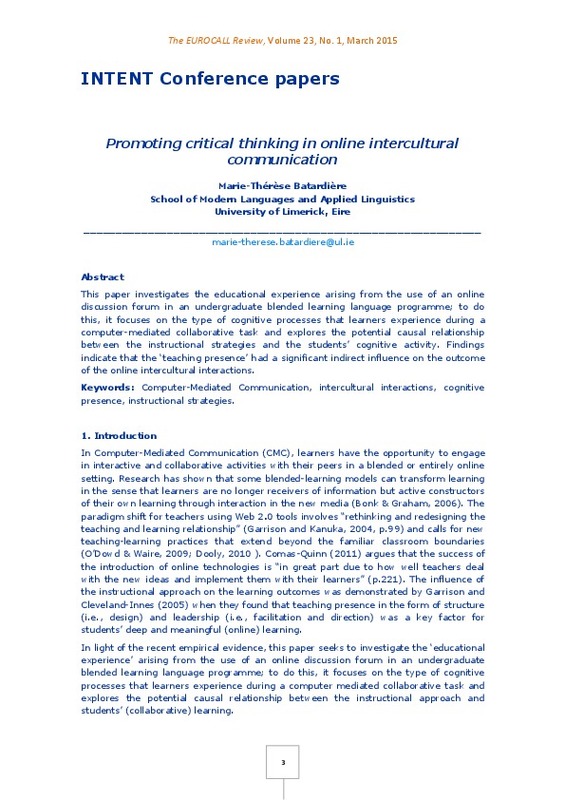JavaScript is disabled for your browser. Some features of this site may not work without it.
Buscar en RiuNet
Listar
Mi cuenta
Estadísticas
Ayuda RiuNet
Admin. UPV
Promoting critical thinking in online intercultural communication
Mostrar el registro sencillo del ítem
Ficheros en el ítem
| dc.contributor.author | Batardière, Marie-Thérèse
|
es_ES |
| dc.date.accessioned | 2017-05-25T11:38:02Z | |
| dc.date.available | 2017-05-25T11:38:02Z | |
| dc.date.issued | 2015-03-30 | |
| dc.identifier.uri | http://hdl.handle.net/10251/81739 | |
| dc.description.abstract | [EN] This paper investigates the educational experience arising from the use of an online discussion forum in an undergraduate blended learning language programme; to do this, it focuses on the type of cognitive processes that learners experience during a computer-mediated collaborative task and explores the potential causal relationship between the instructional strategies and the students’ cognitive activity. Findings indicate that the ‘teaching presence’ had a significant indirect influence on the outcome of the online intercultural interactions. | es_ES |
| dc.language | Inglés | es_ES |
| dc.publisher | Universitat Politècnica de València | |
| dc.relation.ispartof | The EuroCALL Review | |
| dc.rights | Reconocimiento - No comercial - Sin obra derivada (by-nc-nd) | es_ES |
| dc.subject | Computer-mediated communication | es_ES |
| dc.subject | Intercultural interactions | es_ES |
| dc.subject | Cognitive presence | es_ES |
| dc.subject | Instructional strategies | es_ES |
| dc.title | Promoting critical thinking in online intercultural communication | es_ES |
| dc.type | Artículo | es_ES |
| dc.date.updated | 2017-05-25T10:47:08Z | |
| dc.identifier.doi | 10.4995/eurocall.2015.4562 | |
| dc.rights.accessRights | Abierto | es_ES |
| dc.description.bibliographicCitation | Batardière, M. (2015). Promoting critical thinking in online intercultural communication. The EuroCALL Review. 23(1):3-10. https://doi.org/10.4995/eurocall.2015.4562 | es_ES |
| dc.description.accrualMethod | SWORD | es_ES |
| dc.relation.publisherversion | https://doi.org/10.4995/eurocall.2015.4562 | es_ES |
| dc.description.upvformatpinicio | 3 | es_ES |
| dc.description.upvformatpfin | 10 | es_ES |
| dc.description.volume | 23 | |
| dc.description.issue | 1 | |
| dc.identifier.eissn | 1695-2618 | |
| dc.description.references | Akyol, Z., & Garrison, D. R. (2011). Understanding cognitive presence in an online and blended community of inquiry: Assessing outcomes and processes for deep approaches to learning. British Journal of Educational Technology, 42(2), 233-250. doi:10.1111/j.1467-8535.2009.01029.x | es_ES |
| dc.description.references | Anderson, T., Rourke, L., Garrison, D.R. & Archer, W. (2001). Assessing teaching presence in a computer conferencing context. Journal of Asynchronous Learning Networks, 5(2), 1- 17. | es_ES |
| dc.description.references | Arnold, N., & Ducate, L. (2006). Future foreign language teachers' social and cognitive collaboration in an online environment. Language Learning & Technology, 10(1), 42-66. | es_ES |
| dc.description.references | Bonk, C. & Graham, C. (2006). Blended learning systems: definition, current trends, and future direction. In C. J. Bonk & C.R. Graham (Eds.), Handbook of Blended Learning: Global Perspectives, Local Designs, pp. 1-21. San Francisco, CA: Pfeiffer Publishing. | es_ES |
| dc.description.references | Brindley, J., Blaschke, L. M., & Walti, C. (2009). Creating Effective Collaborative Learning Groups in an Online Environment. The International Review of Research in Open and Distributed Learning, 10(3). doi:10.19173/irrodl.v10i3.675 | es_ES |
| dc.description.references | Comas-Quinn, A. (2011). Learning to teach online or learning to become an online teacher: an exploration of teachers’ experiences in a blended learning course. ReCALL, 23(3), 218-232. doi:10.1017/s0958344011000152 | es_ES |
| dc.description.references | Curtis, D., & Lawson, M. (2001). Exploring collaborative online learning. Journal of Asynchronous Learning Networks, 5(1), 22-34. | es_ES |
| dc.description.references | Dooly, M. (2010). The teacher 2.0. In S. Guth & F. Helm (Eds.), Telecollaboration 2.0: Language, Literacies and Intercultural Learning in the 21st Century, pp. 277-303. Bern: Peter Lang. | es_ES |
| dc.description.references | Garrison, D. R., Anderson, T., & Archer, W. (2001). Critical thinking, cognitive presence, and computer conferencing in distance education. American Journal of Distance Education, 15(1), 7-23. doi:10.1080/08923640109527071 | es_ES |
| dc.description.references | Garrison, D. R., & Cleveland-Innes, M. (2005). Facilitating Cognitive Presence in Online Learning: Interaction Is Not Enough. American Journal of Distance Education, 19(3), 133-148. doi:10.1207/s15389286ajde1903_2 | es_ES |
| dc.description.references | Garrison, D. R., & Kanuka, H. (2004). Blended learning: Uncovering its transformative potential in higher education. The Internet and Higher Education, 7(2), 95-105. doi:10.1016/j.iheduc.2004.02.001 | es_ES |
| dc.description.references | Hanna, B., & de Nooy, J. (2003). A funny thing happened on the way to the forum: electronic discussion and foreign language learning. Language Learning and Technology, 7(1), 71-85. | es_ES |
| dc.description.references | Hanna, B. E., & de Nooy, J. (2009). Learning Language and Culture via Public Internet Discussion Forums. doi:10.1057/9780230235823 | es_ES |
| dc.description.references | Levy, M., & Stockwell, G. (2006). CALL Dimensions: Options and issues in computer-assisted language learning. New Jersey: Lawrence Erlbaum Associates. | es_ES |
| dc.description.references | O’Dowd, R., & Waire, P. (2009). Critical issues in telecollaborative task design. Computer Assisted Language Learning, 22(2), 173-188. doi:10.1080/09588220902778369 | es_ES |
| dc.description.references | Shea, P., Hayes, S., & Vickers, J. (2010). Online instructional effort measured through the lens of teaching presence in the community of inquiry framework: A re-examination of measures and approach. The International Review of Research in Open and Distributed Learning, 11(3), 127. doi:10.19173/irrodl.v11i3.915 | es_ES |








